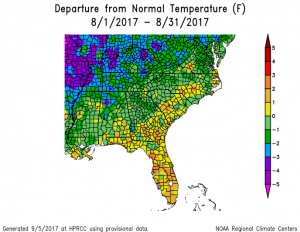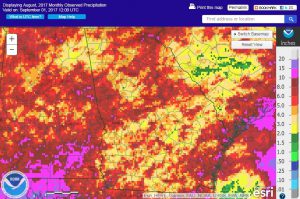August temperatures across Georgia were near normal to slightly above average for most of the state, with the coolest temperatures in the northern half of the state and warmer temperatures farther south. Rainfall in most areas was slightly below or near normal. The exception was the southern part of the state, where lower rainfalls led to the redevelopment of abnormally dry conditions by the end of the month.
In Atlanta, the monthly average temperature was 79.2 degrees F (0.2 degrees below normal), in Athens 78.6 degrees (1.0 degrees below normal), Columbus 82.0 (0.1 degrees above normal), Macon 80.3 (0.6 below normal), Savannah 82.7 (1.2 above normal), Brunswick 82.9 (1.1 above normal), Alma 82.8 (1.5 above normal), Augusta 82.3 (1.8 above normal), Albany 83.2 (1.2 above normal), Rome 79.1 (0.4 above normal), and Valdosta 81.3 (0.1 degrees above normal).
Augusta reported a new high minimum temperature of 78 F on August 16, breaking the old record of 77 F set in 2010. Alma reported a new high minimum temperature of 76 F on the same date, breaking the old record of 75 F, also set in 2010. Brunswick reported a new high minimum temperature of 81 F on August 25, surpassing the old record of 80 F set in 1983. Alma reported a new record low of 60 F on August 1, below the old record of 61 F set in 1966. Low maximum temperatures were also tied at Macon and Savannah this month and high minimum temperatures were tied in Alma and Brunswick.
The highest monthly total precipitation from National Weather Service reporting stations was 5.97 inches in Brunswick (0.30 inches below normal) and the lowest was in Albany with 2.99 (1.85 inches below normal). Atlanta received 5.47 inches (1.57 inches above normal), Athens received 5.47 inches (1.94 inches above normal), Columbus received 4.88 inches (1.11 above normal), Macon 4.90 inches (0.80 below normal), Rome 3.07 inches (1.06 below normal), Savannah 5.75 inches (0.81 below normal), Augusta 5.81 inches (1.55 above normal), Alma 5.01 inches (0.40 below normal), and Valdosta 3.82 inches (1.52 inches below normal).
Several rainfall records were set in August. Atlanta received 1.97 inches on August 10, beating the old record of 1.91 inches set in 1936. Columbus received 1.43 inches on August 30, breaking the old record of 1.34 inches set in 2006. Augusta received 2.45 inches on August 9, surpassing the old record of 2.05 inches set in 1912. Alma received 2.15 inches on August 4, breaking the old record of 2.03 inches from 1970.
The highest daily rainfall total from CoCoRaHS observers was 4.16 inches nsouth of Greensboro in Greene County on August 9, followed by 4.02 inches measured near Dunwoody in DeKalb County on the same date. For the entire month, the highest total was 12.32 inches measured near Savannah in Chatham County followed by 11.89 inches from an observer south of Riceboro in McIntosh County and 11.04 inches on Tybee Island, also in Chatham County.
Isolated wind damage from strong thunderstorms was reported on nine out of 31 days this month.
The dry conditions in south and east Georgia caused a recurrence of abnormally dry conditions by the end of the month, but that is expected to be temporary as tropical rains should eliminate any shortfalls in the next few weeks.
The drier areas of the state were experiencing crop stress during the last two weeks of August, with additional rain needed for moving along the cotton and soybean harvests. However, the corn harvest benefited from the dry conditions. Livestock producers were also worried about the lack of moisture which is needed to establish fall pastures. Whitefly pressure in many areas was intense and was linked to overwintering due to last winter’s mild conditions. Rain in grape-growing regions contributed to the development of rot in some vineyards.
The outlook for September shows that cooler than normal conditions are expected this month, particularly in the first two weeks. Precipitation is also expected to be above normal. For fall, the climate outlook leans slightly towards warmer and wetter than normal conditions. ENSO conditions are expected to remain neutral through the winter.
For more information please see the “Climate and Agriculture” blog at https://site.extension.uga.edu/climate/ or visit our web page at https://www.gaclimate.org. We are now also on Facebook at SEAgClimate and on Twitter at @SE_AgClimate. Please feel free to email your weather and climate impacts on agriculture to share on the blog to pknox@uga.edu.


